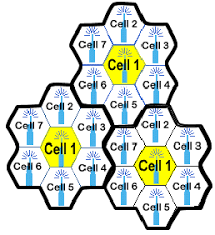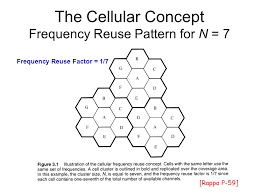
© copyright boddunan.com

© copyright slideplay.com
Some key factors in building a cellular network :
- The network has to cope with large numbers of subscribers
- The radio spectrum has limited capacity
- The radio waves are subject to multi-path propogation, fade over distance and interference limiting the capacity
- Subscribers move, sometimes very fast (200kph by train)
- Instalation of the basestation and back haul network is expensive
The basics of mobile phone technology is that the mobile network operators split the area served by their network into cells; often pictured as hexagons. Each cell is served by a mast and serves a number of mobile stations. The actual size and shape of a cell is determined by a number of factors including the strength of the mast signal; the distance between masts and the topography of the land. In a flat desert with equally spaced masts all of the same strength these cells will indeed be hexagons; but within the UK not really.
If two adjacent mast work at the same frequency then there will be interference where the signals overlap. To avoid this there is usually a gap of a cell between masts that work at the same frequency. This leads to a 7-cell model. However in a modern mobile phone network, frequencies are allocated dynamically dependent on demand. But still the allocation of frequency must avoid overlap and interference.
Mast can be omnidirectional, where the mast is at the centre of the cell. Cell sectorisation is the idea of more directional transceivers often at 120deg, Thus effectively increasing the capacity by 3 times. In roads or rail transceivers that are tuned up and down the highway give capacity to the users of the road or rail and stop the wastefulness of providing a similar capacity in fields or other lowly populated areas.
To further increase capacity, smaller cells can be deployed, effectively cutting the power of a cell. Smaller cells increase the capacity of the network in urban areas. Each new cell has a large overhead, but will add significant capacity. This method of providing small cells also works well at festivals or sports events where upwards of 50,000 people may all wish to use their mobile and small cells can provide the capacity.
*u* ©mobilephonetechnology.co.uk all rights reserved 2017- 2025



